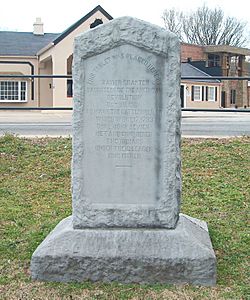Battle of Hightower facts for kids
Quick facts for kids Battle of Hightower (Etowah Cliffs) |
|||||||
|---|---|---|---|---|---|---|---|
| Part of Cherokee–American wars | |||||||
|
|||||||
| Belligerents | |||||||
| Cherokee | Tennessee Militia | ||||||
| Commanders and leaders | |||||||
| Kingfisher | General John Sevier Colonel John Blair Colonel Christian Colonel Kelly Captain Evans |
||||||
| Strength | |||||||
| Several hundred Cherokee | 800 mounted Tennessee volunteers | ||||||
| Casualties and losses | |||||||
| Over 1,000 Cherokee, including women and children | At least 3 killed and many wounded | ||||||
The Battle of Hightower (also known as the Battle of Etowah Cliffs) happened in 1793. It was a part of the Cherokee–American wars. In these wars, the Cherokee people tried to protect their land from new settlers. These settlers were citizens of the new United States. This battle took place at a Cherokee village called High Town (Itawayi). It was near what is now Rome, Georgia. The Cherokee were defeated by a group led by John Sevier. He later became the Governor of Tennessee.
Contents
Why the Battle Happened
The Treaty of Hopewell
In 1785, the Cherokee and the new United States signed a peace agreement called the Treaty of Hopewell. In this treaty, the Cherokee agreed to be under the authority of the United States. The treaty also set aside a very large area of land for the Cherokee. This land was in parts of Tennessee, Eastern North Carolina, South Carolina, and Northern Georgia. It was meant to be their hunting grounds.
The treaty said that any non-Native Americans who settled on this land would lose the protection of the United States. It also said the Cherokee could deal with them as they saw fit.
New Settlers and Growing Conflict
Even with the treaty, new settlers kept moving onto Cherokee land. This led to many attacks by the Cherokee to try and make them leave. The settlers also fought back. Both sides believed the other was breaking the treaty. For example, the United States was supposed to make sure its citizens who harmed Cherokee people faced justice. But this often did not happen. The Cherokee also traded with Spain, which some saw as breaking the treaty.
A Spark for War
Later, the President George Washington approved a plan for a new treaty. This meeting was to happen in the Southwest Territory (which is now Tennessee). However, a group led by John Sevier attacked the meeting place. Many Cherokee people were killed. President Washington ordered that the leader of this attack, Captain John Beard, be arrested. But Sevier helped Beard escape, so he never faced trial.
In response, a Cherokee war leader named John Watts led a large group of over 1,000 Chickamauga Cherokee and Muscogee Creek warriors. They attacked settlements that were built without permission on Cherokee land. They were planning to attack Knoxville, Tennessee.
Near Knoxville, the Cherokee attacked a settlement called Cavett's Station. Some people were killed on both sides. The settlers who survived gave up when Watts offered to let them go safely. But some Cherokee warriors, led by Doublehead, did not agree with this. They started harming the prisoners, including children. Another Cherokee leader, James Vann, tried to protect the prisoners from Doublehead's group.
The Battle of Hightower (Etowah Cliffs)
When news of these events spread, John Sevier quickly gathered a fighting force. The Cherokee warriors had to split up. Some went towards Kentucky, some towards North Carolina, but most headed towards Georgia. Sevier's men caught up with the Cherokee at a village he called Hightower. This village was also known as Etowah, or Itawayi. It was located near where Rome, Georgia is today.
The Cherokee set up a strong defensive position on a place called Myrtle Hill. They also had guards trying to stop Sevier's men from crossing the rivers.
Sevier wrote about the battle. He said he tried to cross the Etowah River about a mile south of Myrtle Hill. This made the Cherokee defenders leave their prepared spots. Then, Sevier's men quickly rode back to Myrtle Hill to cross the river there. The Cherokee rushed back to stop them from crossing the Etowah, but they failed. When the Cherokee war chief, Kingfisher, was killed, the remaining warriors ran away. Sevier then burned the village.
What Happened After
With no one left to fight them, Sevier's group moved west along the Coosa River. They destroyed more Cherokee and Creek villages before returning to the Knoxville area. The Battle of Hightower was the last of Sevier's many battles against Native American groups. It became known as his Etowah campaign. It was also the last major battle between the Lower Cherokee, led by John Watts, and American forces until the Nickajack Expedition in September 1794.
Today, Myrtle Hill is a cemetery. There is a stone monument on the hill that remembers this battle.


